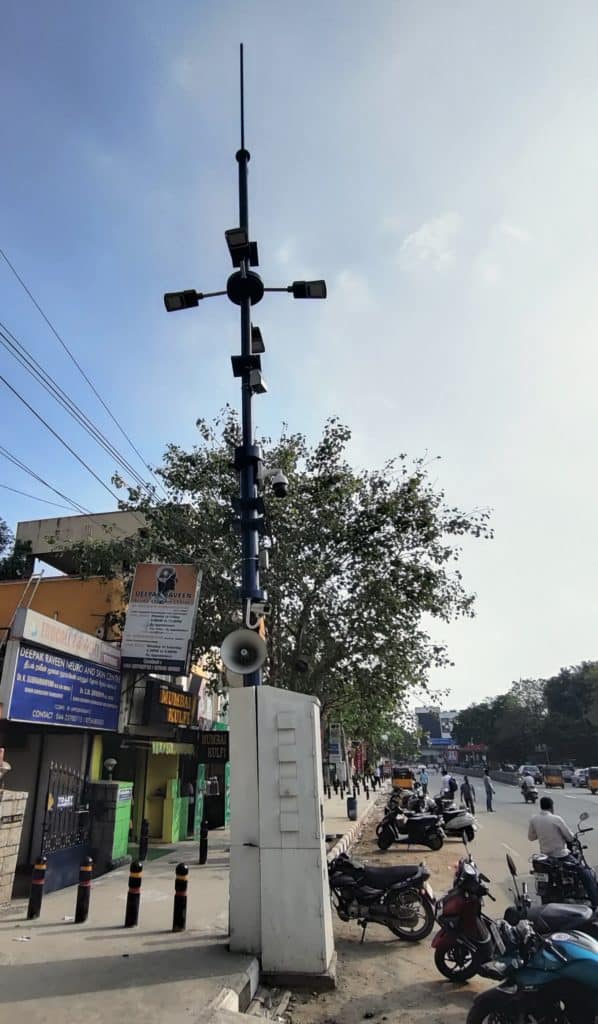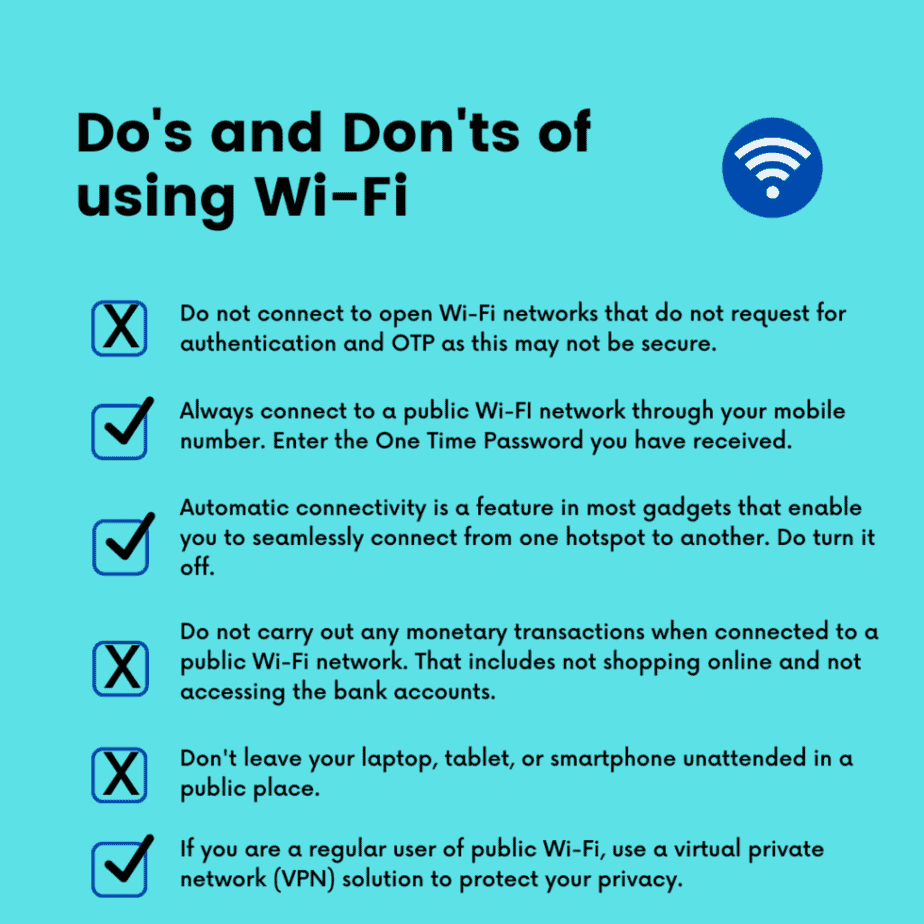A vertical pole stands tall at the Ashok Pillar junction, right next to the bus stop. Apart from a loudspeaker, a street lighting system and a CCTV camera fixed to the pole, it also sports a Wi-Fi router. Any member of the public can access free Wi-Fi in this area for half-an-hour at the speed of 2Mbps. That’s a smart pole for you! Chennai has 50 such smart poles.
Internet service for the 50 smart poles has been provided by Airtel, as part of their Corporate Social Responsibility. According to a senior official from Chennai Smart City Limited, the approximate cost of providing Wi-Fi access across these 50 smart poles would be Rs 1.25 crore (at around Rs 2.5 lakh per point).
Chennai’s Central Railway station was the first public space in the country to get free Wi-Fi in 2014. It was a successful venture with many consumers accessing the Internet at the station to book tickets, read news and scroll Facebook.
Apart from free services provided by Southern Railways and commercial establishments (such as cafes and restaurants), public Wi-Fi spots were also an integral part of the Smart City Mission’s Integrated Command and Control Centre (ICCC) approach. Key aspects of this approach include providing IT-enabled services for citizens and businesses, digital signage, smart poles and data centre and disaster recovery.
In addition to the 50 smart poles, ACT Fibernet has partnered with Greater Chennai Corporation (GCC) to set up free Wi-Fi zones across Chennai. “We have about 40-50 Wi-Fi zones currently active at Amma Canteens, T-Nagar Panagal Park, Nageshwara Park and other parts of the city. We are working on around 100 more Wi-Fi zones across North Chennai which will be live in the next few months,” Sandeep Mohan Gupta, Chief Operating Officer at ACT Fibernet told us.
Sandeep further added that ACT is partnering with other government agencies to create Wi-Fi zones in the city’s government hospitals, public libraries, metro Stations and parks.
Few takers
But while public Wi-Fi hotspots are plenty in the prime locations of Chennai, the response from the public has been lukewarm. An auto-driver from Ashok Pillar, S Satheesh’s knowledge of the pole is limited to its existence. “I know there is a pole at the end of the street. But I don’t know what it’s for,” he said.
Passers by and shopkeepers also appear oblivious of the advantages of the smart pole located at T Nagar bus stand, a commercial location. It is rare to find a person who knows how to use these services. “I thought it was an advanced lighting system. Now that you have approached me, I know we may also use free internet in the vicinity of these poles,” said V Sirisha, who was watching a Tamil soap on her mobile internet, as she waited for her bus.
Many of the regular customers at the Amma canteens are also clueless that they can use free WI-FI (ACT fibernet is the service provider) at these eateries. A few of them, who do have a vague idea, don’t seem excited about the offer. “My phone supports no internet. Most of those who come here have basic phones. Free Wi-Fi at the canteens serves absolutely no purpose,” said Mani Kumar, a street vendor who eats at one of these canteens regularly.
There are some takers for the public Wi-Fi hotspots in railway stations and cafes, but recently launched services by GCC remain largely unused still.
A GCC official said that there have been no enquiries or suggestions from the general public about public Wi-Fi. “The 1913 helpline of GCC receives many complaints and suggestions from the general public regarding civic amenities. We have never received complaints, or even queries regarding free internet services. This shows that people are not really interested in the service,” the official, seeking anonymity, said.
“Those who can afford to own a smartphone can very well pay for mobile internet. It is so cheap these days. Why would people go for free Wi-Fi?”
Harish Kishore, college student
For GCC, fighting a pandemic and focusing on big-ticket infrastructure projects such as flyovers, sensitising the general public about free internet is not a priority, he added.
Some, who are even aware of the offer, are in fact hesitant to use the services. “I am afraid public Wi-Fi users could be easy prey for hackers. There is no information in the public domain about how safe these smart poles or the Wi-Fi at the Amma canteens are,” said Harish Kishore.
Also Read: Do Cubbon Park and Lalbagh need Wi-Fi? Visitors say no!
How safe is public Wi-Fi
Gadgets connected to public Wi-Fi networks are susceptible to security risks, says Pravin Kalaiselvan, founder of Save Them India Foundation, an NGO working in the space of cybersecurity.
“It is easy to hack a gadget connected to public Wi-Fi. A hacker can easily access the cards and passwords that are saved. The firewalls and security coding of the Wi-Fi should be strong. Multiple security layers can also prevent such risks,” said Pravin.
However, internet service providers assure multi-layered security at public Wi-Fi spots. “We (ACT) have multiple levels of firewall in our access and core networks to ensure that the security and protection are unmatched and robust,” said Sandeep.
When asked if they have faced any incidents of hacking in public Wi-Fi hotspots, he said, “Because of timely security upgrades and keeping up with the threats identified all over the world, we have not come across any hacking incidents over our public Wi-Fi.”
The officials of Airtel Broadband services did not respond to our calls.
The unexplored case of public Wi-Fi
Free internet in railway stations of India has been a success, with many passengers utilising the facility during their travels. Many heart warming stories back the claim. Three years ago, a porter in Ernakulam of Kerala, Sreenath K used the free internet service to crack the Kerala Public Service Examination. An auto-driver using free internet at Kollam junction to download study material for her school-going son is another example of how such facilities may be used to bridge the intracity digital divide.
Taking inspiration from these cases, GCC should promote their free Wi-Fi services in Chennai and ensure that those who need it the most are enabled to use it. “Let’s talk about the poor living in slums. During the pandemic, many students who could not afford internet services had to go to schools to collect the reading material. The civic body should have promoted free Wi-Fi among these sections then,” said Anupriya Murugesan, a social worker.
A consumer of free Wi-Fi at Railway stations of Tambaram and Chennai Central, she said that the Wi-Fi notifications turn up the moment she enters the stations. “I have never noticed such notifications while using the roads that have free internet services in Chennai,” Anupriya added.
On December 2020, the central government approved a framework for public Wi-Fi networks through PM Wani scheme. The scheme aims to provide free internet across the country through broadband internet services. However, if the city wide initiatives of public Wi-Fi are not making any progress, how successful will the PM Wani scheme be?
“There should be a strategy to take the scheme to the masses. Otherwise, it would be akin to the Google station programme (a project by Google to provide free Wi-Fi in the railway stations) that had to be shut down last year,” Anupriya said.
Public Wi-Fi is a costly affair. Unless the GCC and Chennai Smart City find ways to sensitise the general public about the presence and potential of public Wi-Fi, simultaneously ensuring safety of use, the concept will remain a checked box in their agenda, with little impact on the ground.
Also read:


Free WiFi could be provided in designated well-lit areas of local parks which could be used by needy children to access study materials and online classes. The GCC could even provide tables and benches for children to use. The free WiFi would serve an immense need rather than waste it on fleeting access in the middle of roads.